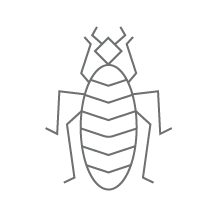
Commercial and Residential Pest Control Services | Dodson Bros. Exterminating Co., Inc.
Camel Crickets

Camel crickets are nocturnal, or active at night, and hide during the day. They often overwinter as young nymphs or adults. Females lay their eggs in early spring and they hatch during April. Camel crickets do not chirp. Camel crickets leap when they are frightened since it's the only defense mechanism they have to scare off predators.
Camel crickets do not pose any health threats to humans, but they can become a nuisance if they gain entry to the home. Some species have been known to damage clothing and other fabrics like curtains.
Reduce areas of moisture in and around the home. A dehumidifier is recommended to prevent moisture build up indoors. Additionally, homeowners should seal all possible points of entry around the house, keep crawl spaces, basements and attics well ventilated, and store firewood at least 20 feet away from the house.
House Crickets

House crickets are nocturnal or active at night and usually hide in dark warm places during the day. Outside, they feed on plants and dead or live insects, including other crickets. Indoors, house crickets can feast on fabric, eating large areas, leaving holes and are especially attracted to clothes soiled with perspiration. When cold weather approaches, they seek shelter in houses and sheds because of the moisture and warmth they provide.
Clothing and carpets can become damaged when house crickets enter homes. They typically feed on the surface, leaving the area roughened from pulling the fibers loose while eating.
Reduce areas of moisture in and around your home. Mow the lawn, weed plant beds and move woodpiles away from the structure. Provide adequate ventilation in crawl spaces, basements, etc. In addition, change outdoor lighting to less-attractive yellow bulbs or sodium vapor lamps. It is also important to seal possible points of entry for house crickets around the house, including window and door frames.






















